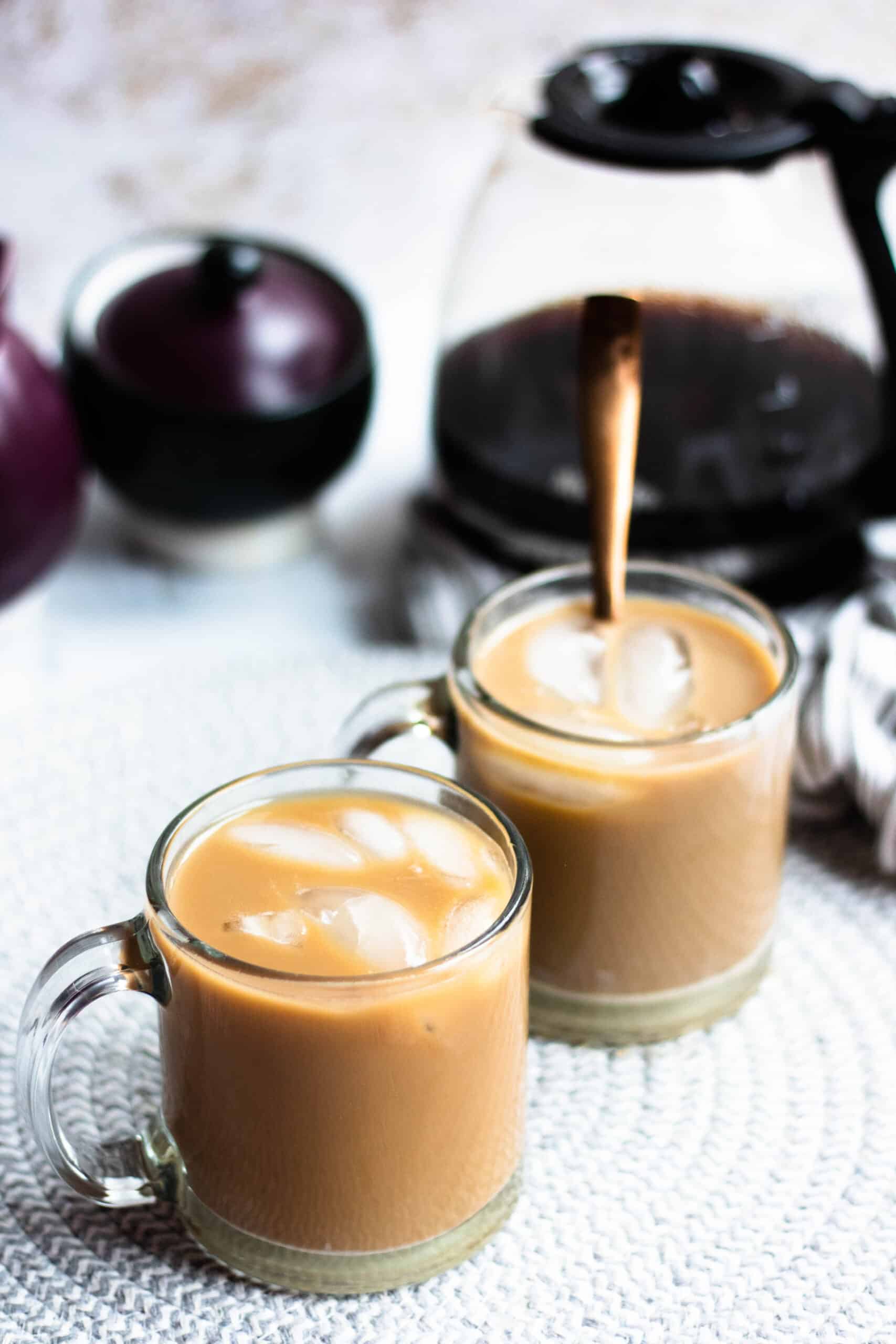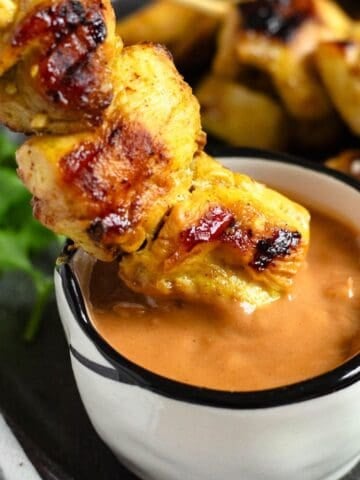Thai Coffee and Vietnamese Coffee look very similar, but there are several differences! From the type of beans and milk to the brewing and filtering each of these drinks is worth a try!

Southeast Asia is full of beautiful countries, unique traditions, and delicious food. It is also home to a strong coffee culture.
Upon first inspection, many might think Vietnamese iced coffee and Thai coffee are the same. Both are usually served cold over ice, with milk and a sweetener, but that’s where their similarities end.
Once you’ve had a taste, you’ll see why these two types of coffee should not be mixed up. If you love coffee and want to learn a bit more about Vietnamese coffee versus Thai coffee, read on!
Origins of Thai Coffee and Vietnamese Coffee
Thailand and Vietnam are both major players in the world’s coffee production.
Robusta and Arabica coffee have been grown in Thailand for centuries. In the 1970s, Thailand began exporting coffee as a way to help poorer communities, and the trade quickly took off. Today Thailand exports robusta beans all over the world.
Vietnam was first introduced to coffee production by French invaders in the 1850s. The Vietnam War made exporting coffee very difficult for many years, but since then the country has been able to bounce back and produce high-quality coffee.
What is Vietnamese Coffee?

Vietnamese coffee is a typically cold (cà phê sua dá) coffee, served with sweetened condensed milk over crushed or cubed ice.
It’s a strong and smooth coffee that gets a unique flavor from the way the beans are brewed and filtered, using a phin filter. The filter produces a concentrated coffee with a strong flavor and aroma that is difficult to replicate.
This concentrated brew is used for several types of coffee drinks including:
- Yogurt coffee (cà phê sữa chua)
- Egg coffee (cà phê trứng or hanoi egg coffee)
- Iced coffee, which is the most popular type
Each type has sweetened condensed milk added which is very sweet and rich and makes the drink extra sweet too.
What is Thai Coffee?
Thai coffee is made with robusta coffee beans in a pot called a cafetiere which uses a muslin filter called tungdtom. This brewing method produces a coffee that is strong, flavorful, and a little bit bitter. Sesame seeds and cardamom add additional flavor to the brew.
It is most often served over ice with evaporated milk, condensed milk, or regular milk and sugar. It’s perfect to enjoy on hot summer days.
Different types of Thai coffee include:
- Thai iced coffee made with coffee, condensed milk, and evaporated milk
- Oliang Coffee made from robusta beans and sugar
- Yok Lor OliangCoffee, sugar, and evaporated milk
- Kopi Coffee and condensed milk
Coffee Beans
There is some debate over whether Vietnamese coffee and Thai coffee are made from robusta or arabica coffee beans. It seems that authentic Vietnamese and Thai coffee drinks are made with robusta, but arabica may be used in some cafes and is recommended by many coffee drinkers.
Both Thailand and Vietnam are known for producing high-quality robusta beans that are used in their coffee and are popular for instant coffee. Both countries also produce arabica, which is milder and sweeter.
Generally, robusta beans are what is used for Thai iced coffee. Robusta beans are known for their very bold, bitter flavor. Some might consider the flavor to be too harsh, but it is softened a bit in Thai coffee with milk and sugar.
Robusta beans contain more caffeine than arabica and are less expensive to produce, but they have a more bitter aftertaste.
Vietnamese coffee is often made with arabica or robusta beans. Arabica beans have a sweeter, milder flavor that is more complex and more popular among everyday coffee drinkers.
Arabica beans are roasted and ground into a powder before they are brewed for Vietnamese coffee.
Filter

One of the main differences between Vietnamese and Thai coffee is how it is filtered.
The metal phin filter used to process Vietnamese coffee is a vital part of creating the perfect cup of Vietnamese coffee.
This special filter allows you to create a very customized cup of coffee by controlling the temperature of the water and agitation of the ground coffee beans. The coffee is extracted more slowly than a typical French press, through a metal ring, which results in a coffee that is smooth, rich, bold, and totally unique.
Thai coffee uses a coffee sock drip filter called a tungdtom filter. This muslin bag filter allows for a faster drip, so the coffee flavor is not as bold, bitter or acidic as Vietnamese coffee.
The different methods for filtering make a big difference for those who like or dislike an intense flavor. If you like intense flavor, Vietnamese coffee is the way to go. But if you like a flavor that is a bit softer, you would probably prefer Thai coffee.
Milk
Another big difference between the two types of coffee is the milk used.
Vietnamese coffee is usually made with sweetened condensed milk while Thai coffee uses condensed milk, evaporated milk, or regular milk.
Sweetened condensed milk is very thick and sweet, which pairs wonderfully with the strong flavor of Vietnamese coffee.
Sweetness
Vietnamese coffee is typically sweeter than Thai coffee, thanks to the addition of sweetened condensed milk.
While Vietnamese coffee is considered sweeter, it is also bolder in flavor. It’s the complexity of both the sweet and bitter flavors that makes it interesting.
Thai coffee is generally milder and not as rich as Vietnamese coffee, which many people prefer. It can even be enjoyed without any milk at all because the beans are naturally sweeter and brown sugar is often added.
Caffeine Content
Both Vietnamese and Thai coffee will have natural caffeine. The amount of caffeine in Vietnamese coffee will be higher because of the brewing process and the concentrated coffee that comes from the phin filter.
Robusta beans have more caffeine than arabica beans.
Availability

Thai Coffee is generally more available and less expensive than Vietnamese coffee. It has a mild, milky flavor that is more popular than the bold flavor of Vietnamese coffee and it calls for robusta beans which are cheaper to produce.
Vietnamese coffee is not as widely produced but you can find it in some Asian grocery stores and coffee shops.
Flavor
Deciding which coffee drink tastes better is a matter of personal preferences.
Vietnamese iced coffee is a flavorful coffee with a unique flavor profile. The intense bitter taste is carefully balanced by the strong sweet flavor of sweetened condensed milk.
Thai coffee has a more mild coffee taste, sweetened with fresh milk and brown or white sugar. It’s a more popular beverage than its Vietnamese counterpart, but it may have a more bitter aftertaste because it is missing the sweetener.
FAQs
Egg coffee is a very rich dessert coffee drink found in Vietnam. To make it, an egg is whipped with sweetened condensed milk and added to the top of a cup of coffee. Vietnamese Egg Coffee may sound strange but it’s a delicious treat that cannot be found anywhere else.
Thailand and Vietnam are both big producers of robusta beans and these beans are known for a very intense, strong flavor. This strong flavor is perfect for both Vietnamese and Thai iced coffee drinks. Arabica beans are considered a more high-quality coffee bean with a slightly milder, sweeter flavor than robusta.
Authentic Vietnamese or Thai coffees are made with robusta beans but arabica beans could also be used to produce a great-tasting cup of coffee.






Leave a Reply